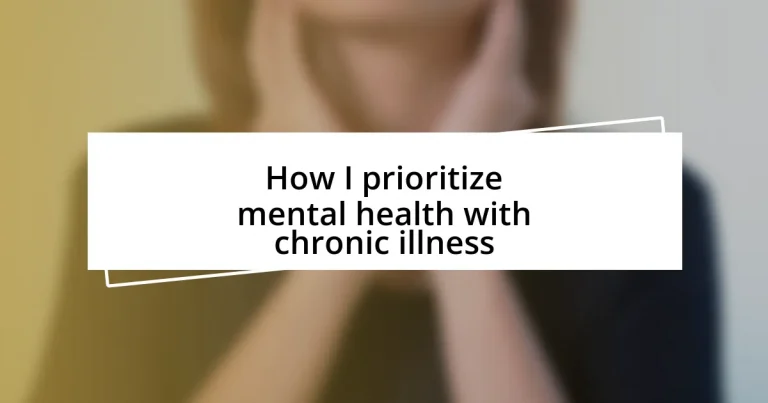Key takeaways:
- Recognizing personal mental health needs includes differentiating between physical fatigue and emotional exhaustion, emphasizing the importance of connection and joyful activities.
- Setting realistic health goals transforms the journey by focusing on achievable targets, fostering motivation, and allowing for flexibility in daily routines.
- Creating a supportive environment enhances emotional well-being through positive interactions, open communication, and personalized spaces for relaxation.
- Utilizing mindfulness and seeking professional support, including therapy and medication, are crucial steps in effectively managing mental health alongside chronic illness.
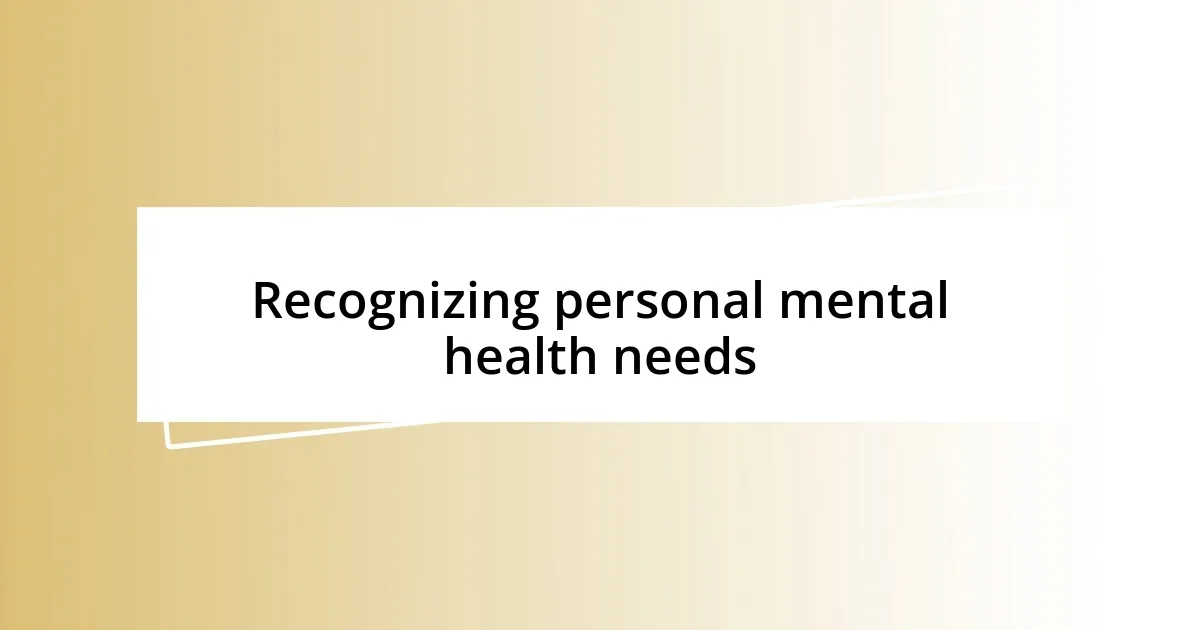
Recognizing personal mental health needs
Recognizing my mental health needs has often felt like peering through a foggy window. In those quiet moments, I’ve had to ask myself, “What do I truly need right now?” Acknowledging the difference between physical fatigue and emotional exhaustion has been crucial for me.
Sometimes, I notice shifts in my mood that are difficult to articulate. For instance, when I’m stuck in a flare-up, I find that I’m not just dealing with the physical pain; I often feel isolated and overwhelmed. That realization led me to understand that I need to prioritize connection with friends, even if a phone call is all I can manage.
I often reflect on what brings me joy and reassurance, and I’ve learned it’s vital to create space for those activities. Whether it’s journaling my thoughts or simply allowing myself to watch a favorite show, honoring these needs has made my journey with chronic illness feel more manageable. Isn’t it liberating to recognize what lights up your spirit, even on the darkest days?
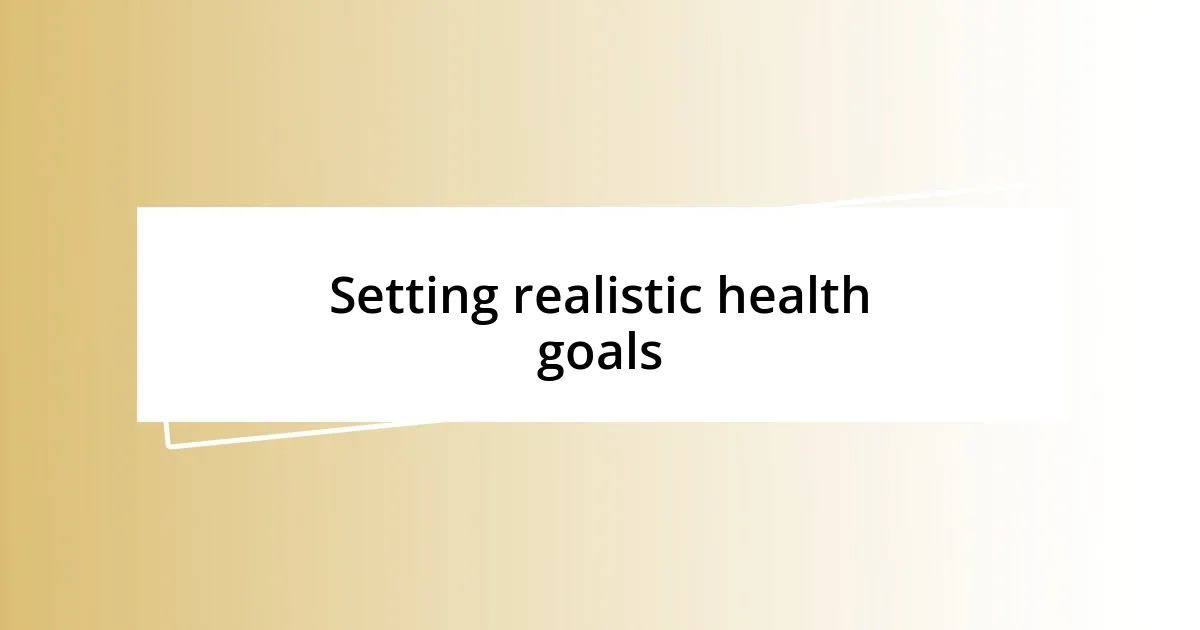
Setting realistic health goals
Setting realistic health goals has been a transformative practice in my journey with chronic illness. In the early days, I often aimed for lofty achievements, like running a marathon or working out every day. But challenging my own expectations taught me the importance of smaller, achievable targets. For example, I now set a goal to take a short walk three times a week instead of a daily exercise routine. This shift has not only helped me stay motivated but has also made me feel accomplished without overwhelming myself.
I remember a time when setting goals felt more like setting myself up for failure. I aimed to work full-time while managing my health, only to crash and burn from stress and fatigue. Through trial and error, I learned to reduce my workload by breaking tasks into manageable pieces. This has been crucial in maintaining balance, allowing me to dedicate time to self-care activities that truly support my mental well-being. It’s fascinating how even the smallest wins can boost your confidence and motivate you to move forward.
Seeing my limitations as opportunities has reshaped my perspective. Instead of viewing a flare-up as a setback, I now consider it a reminder to focus on what I can achieve within those constraints. On difficult days, I adjust my goals, allowing for more rest or mindfulness practice. The process of adapting my objectives keeps me grounded and more in tune with my mental health. Have you ever felt that adjusting your goals could open new doors in your wellness journey? I certainly have.
| Traditional Goal-Setting | Realistic Goal-Setting |
|---|---|
| Setting lofty goals without considering limitations | Defining smaller, achievable objectives based on current energy levels |
| Potentially leading to discouragement and burnout | Fostering motivation and a sense of accomplishment |
| Rigid plans that don’t adapt to changing circumstances | Flexible goals that can be adjusted to fit daily realities |
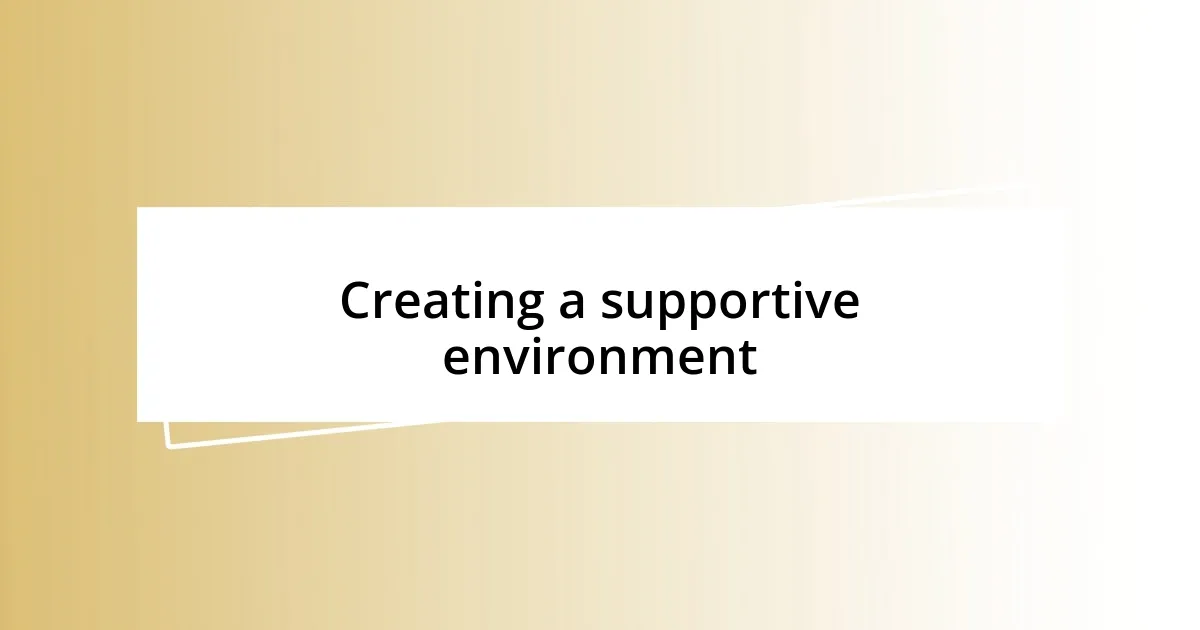
Creating a supportive environment
Creating a supportive environment has been a game-changer in my mental health journey. I’ve realized that the space around me greatly impacts my emotional well-being. When I surround myself with positivity and understanding, it becomes easier to navigate my chronic illness. For instance, I’ve curated my living space by adding soft lighting, comforting textures, and my favorite books to create a cozy refuge where I can recharge. Those little touches make a significant difference on tough days.
To truly build a supportive atmosphere, it’s essential to have open lines of communication with friends and family. I make it a point to keep my loved ones informed about my needs and limitations. This transparency not only fosters understanding but also helps them know how to support me better. Here are some steps I found effective in creating that supportive environment:
- Designate a safe space: Set aside an area in your home that feels calming and nurturing, where you can retreat when you need to recharge.
- Limit negativity: Surround yourself with people who uplift you, while gently distancing from toxic influences that drain your energy.
- Utilize visual reminders: Incorporate items that stimulate positive emotions, such as photos, quotes, or artwork that inspires you.
- Encourage routine check-ins: Regularly connect with friends or family members to share feelings, celebrating small wins and discussing any challenges together.
- Seek understanding: Let your loved ones know how they can help, such as joining you for a gentle activity or just being there to listen.
By consciously crafting my surroundings and addressing my needs, I’ve found a sense of peace that strengthens my mental resilience. It’s been incredibly rewarding to witness how a little effort in creating the right environment can have a profound impact on how I feel day to day.
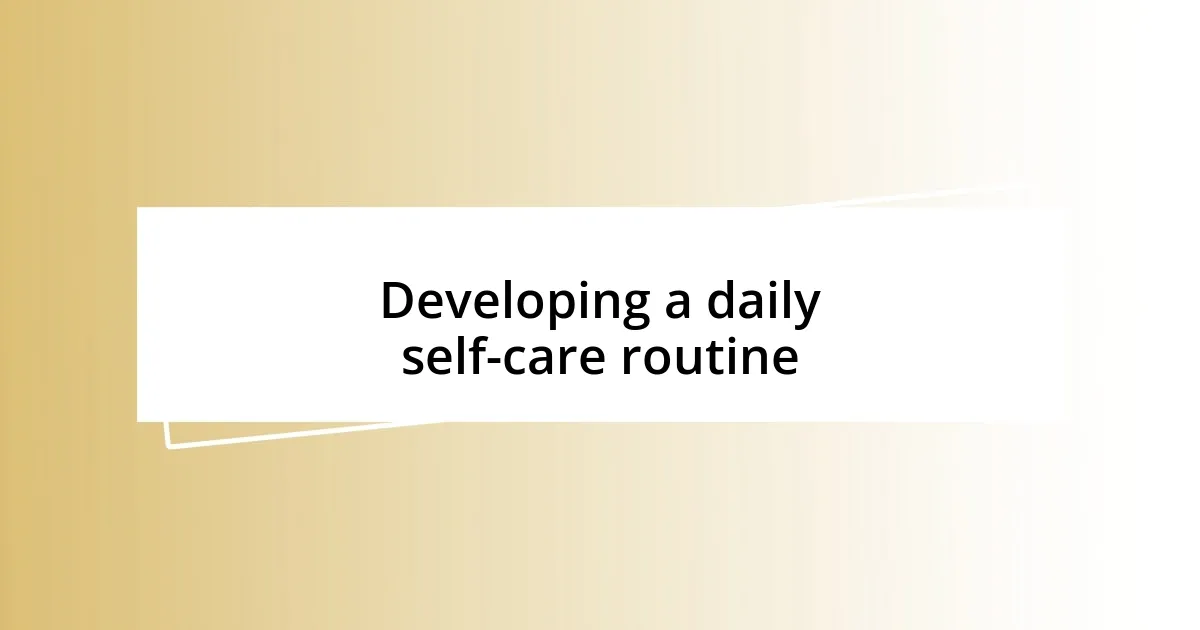
Developing a daily self-care routine
Developing a daily self-care routine has been one of the most essential tools in managing my mental health alongside chronic illness. I remember waking up some mornings feeling like a heavy fog was hanging over me, making even the simplest tasks seem exhausting. By establishing a consistent routine that starts with gentle stretching and mindful breathing, I’ve found that I can lift that fog. It’s remarkable how these small practices set the tone for my day and provide a sense of control, don’t you think?
I’ve also realized that self-care isn’t just about following a script; it requires flexibility. Some days, I might feel up to journaling or reading, while others might call for a soothing bath or a short walk outside. Listening to what my body needs each day has transformed how I approach self-care. There was a time when I pressured myself to stick rigidly to a checklist, only to end up frustrated. Now, I embrace the ebb and flow of my energy levels, which allows me to genuinely enjoy the small moments that self-care brings.
Incorporating elements that resonate with my interests has also deepened my routine. For instance, I try to include a moment of creativity, be it through painting, writing, or crafting. Those are my escapes, and I often lose track of time when I’m engaged. I’ve learned to celebrate those happy distractions as part of my self-care, which has been a game-changing insight. Do you have creative outlets that bring you joy? Finding ways to blend self-care with personal passions has not only enhanced my routine but turned it into a daily expression of self-love and understanding.
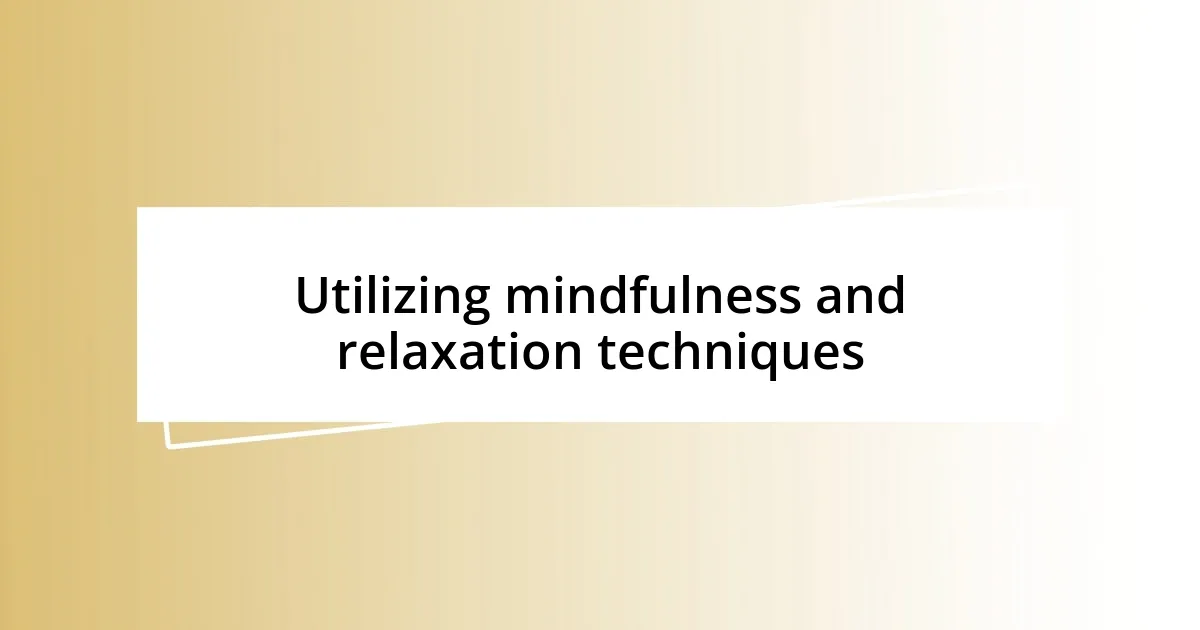
Utilizing mindfulness and relaxation techniques
Utilizing mindfulness and relaxation techniques has truly transformed how I cope with chronic illness. I often find myself sitting quietly with a warm cup of tea, taking deep breaths to center my mind. It’s amazing how just a few minutes of focusing on my breath can melt away the tension that accumulates throughout the day, making me feel more grounded and present. Have you ever taken a moment to simply breathe? It sounds simple, but it’s incredibly powerful.
One technique that has become my go-to is guided meditation. I remember the first time I tried it; I wasn’t sure if I’d be able to quiet my racing thoughts. But as I followed a calming voice guiding me through visualizations, I found that it was like giving my mind a much-needed mini-vacation. The imagery of walking through a serene forest or lying on a warm beach helped disconnect me from pain and worry, even if only temporarily. Have you considered trying guided sessions? They can make a world of difference when navigating the ups and downs of chronic illness.
Incorporating relaxation exercises has also been a revelation. Progressive muscle relaxation, where I tense and then release each muscle group, helps me physically recognize where I’m holding stress. It feels freeing to consciously let go of that tension. I can’t help but think: how often do we unknowingly harbor stress in our bodies? This practice not only aids my physical comfort but also enhances my emotional state, weaving mindfulness into my daily life. It’s a gentle reminder that I have the power to reclaim my calm, one breath at a time.
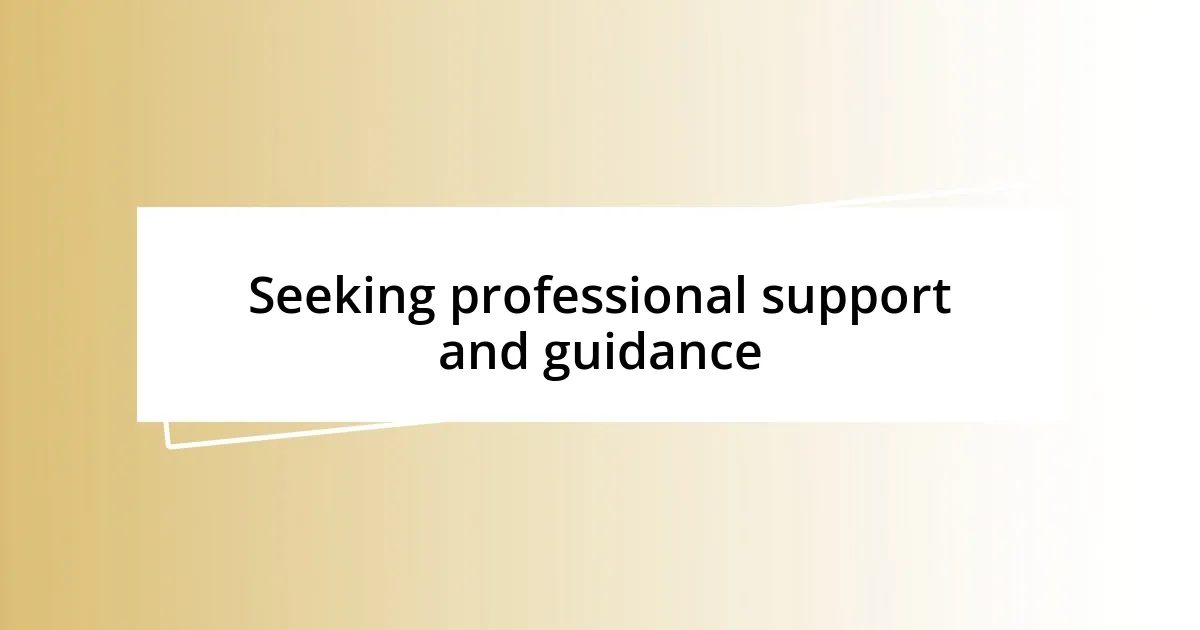
Seeking professional support and guidance
Seeking professional support and guidance has been a profound step in my journey towards managing my mental health amidst chronic illness. When I first sought therapy, I wasn’t sure what to expect. I remember feeling nervous as I sat in the waiting room, my heart racing. But once I started talking to my therapist, it was like unburdening a heavy backpack filled with rocks. The space to express my thoughts and feelings without judgment has been invaluable.
There have been moments where I felt utterly lost or overwhelmed, and my therapist provided tools to help navigate those challenges. For instance, when I shared my struggles with self-doubt, she introduced cognitive behavioral techniques that empowered me to reframe negative thoughts. I can’t emphasize enough how transformative it was to learn that I had the power to shift my perspective. Have you ever felt that moment of clarity when someone offers you a new way to look at a problem? It’s enlightening and motivating.
Additionally, considering medication was a significant step for me. While I approached the idea hesitantly, my doctor helped me understand the potential benefits and risks. I onced struggled with anxiety that seemed impossible to shake off, and finding the right medication was a process of trial and error, but it made a world of difference. It taught me the importance of not only seeking help but understanding that we’re all on our own unique journeys. Have you explored the option of medication in your health care discussions? Sometimes, the right support can help illuminate paths we didn’t even know were available.












